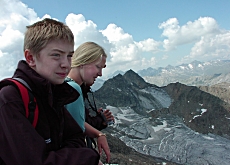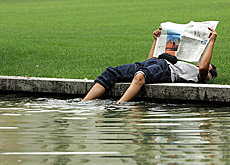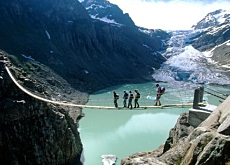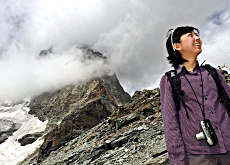Climate kids chilled by glacial retreat

Winners of a British youth competition to raise awareness of the problem of climate change have come to Switzerland to experience global warming first hand.
The “climate change champions” spent part of the first day of their visit walking across the last remains of a once formidable alpine glacier.
The nine children aged between ten and 18 were selected from among 600 entrants for their written and audiovisual projects designed to show how everyone, young or old, can make a contribution to reducing greenhouse gas emissions.
As part of the prize, they were rewarded with a train trip to Switzerland to see the effect global warming is having on the once mighty alpine ice fields.
“This is just overwhelming, and it’s so obvious what we are doing to the glaciers,” said 14-year-old Jordan Stephens after his first icy encounter. “The way they are melting and retreating, it’s as if they are literally being kicked back.”
But before they journeyed by cable car from the valley floor to the Gurschen Glacier above the village of Andermatt, Jordan and the other members of the youthful group were given a word of chilling advice from a leading Swiss glaciologist to “have a good look and take a good picture, it may have historical value one day.”
The scientist, Wilfried Haeberli of Zurich University, used aerial photographs and satellite images to show the attentive kids that alpine glaciers have lost around 50 per cent of their total area since 1850.
“If we say that the glaciers may disappear in the coming decades, this means during the lifetime of these children,” Haeberli told swissinfo. “Glaciers are a general indicator of an accelerating change which brings geo systems and eco systems into disequilibrium.”
Standing at 3,000 metres above sea level, the “champions” found themselves on a wooden platform, looking down on the remains of a glacier covered by a synthetic white blanket.
Blanket coverage
The high-tech material was first deployed a year ago to prevent the snow covering the glacier from melting away, and with it, access to the ski runs. The international press besieged Andermatt when word got out about the novel approach the village had taken to protect the glacier.
The reports swayed the British government’s environment agency, which launched the climate change initiative, to choose Switzerland and the Gurschen Glacier for the field trip.
“This glacier is a real example of the effect of climate change,” explained the agency’s Alex Palman. “The champions will go back with this new-found knowledge and help spread the word about [global warming].”
Peter Heinzer, director of the ski lift company, said they would have had to spend around SFr200 million ($162 million) on advertising to generate as much publicity as the ski resort received from the hundreds of press reports. But Heinzer admitted that Andermatt would probably be among the long-term losers.
Imagination
The talks and lectures were followed by a climb down the rocky southern side of the summit to a dirty patch of snow and ice. The kids had to use their imagination to picture how big it must have once been.
It was clear evidence that global warming has put the world on a very slippery slope – a message the youth said they were going to take home with them.
“I want to show as many photographs as I can of what we’ve seen today,” said 15-year-old Carri Swann. “I want to tell people exactly how many years it’s going to take for all the glaciers to be gone, and I want to try to communicate just how important it is to keep the glaciers here.”
“We have to definitely wise up, because the consequences are bad. We can lose nature and beautiful sites like this,” said 12-year-old Aazim Ihsan.
“I’m going to keep telling them what I’ve always told them, that basically climate change is happening, and they might live in the here and now but the glaciers’ retreat is a sign that we have to change our behaviour,” added Sofia Zabolotskih, a 17-year-old from the West Midlands.
Besides taking pictures of the dying masses of ice visible all around them, the young people also interviewed each other for the blogs they are writing on their Swiss experience.
But they did find time to be kids. Scooping up handfuls of melting snow, they had an old-fashioned snowball fight.
swissinfo, Dale Bechtel in Andermatt
By the 1970s, alpine glaciers had lost 35% of the total area they covered in 1850 – the end of the little ice age.
The rate has accelerated since then and the remaining ice cover was down to 50% in 2000 compared with 1850.
In the coming decades, the glaciers will be reduced to 10% of their 1850 area if temperatures rise by 3 degrees Celsius.
(Statistics and forecasts from the Department of Geography, Zurich University)
The British government has spent £12 million (SFr28 million) on the initiative, to raise awareness of climate change.
As part of the project, nine young people between the ages of 10 and 18 were selected to spread the word across the country.
They were chosen from 600 entrants, who were asked to use different types of media to communicate the threats of climate change in their regions.
They will spend a year as “climate change champions”, giving talks and presentations throughout Britain.

In compliance with the JTI standards
More: SWI swissinfo.ch certified by the Journalism Trust Initiative





You can find an overview of ongoing debates with our journalists here. Please join us!
If you want to start a conversation about a topic raised in this article or want to report factual errors, email us at english@swissinfo.ch.